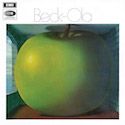Released in the summer of 1969, the Jeff Beck Group’s second album, Beck-Ola, famously included this note from Beck: “Today, with all the hard competition in the music business, it’s almost impossible to come up with anything totally original. So we haven’t…. However, at the time this album was made, the accent was on heavy music. So sit back and listen and try and decide if you can find a small place in your heads for it.”
In retrospect, it’s clear that Beck was being unduly modest. Along with its immediate predecessor, Truth, Beck-Ola was an essential bridge by which hard rock crossed over into heavy metal. Powered by Beck’s Les Paul-driven riffs and Rod Stewart’s serrated vocals, the Jeff Beck Group came off as more earthy and gritty than their stylistic siblings, Led Zeppelin, who were beginning to stake their own place in the “heavy” music genre. Fleshed out with Ron Wood’s superb bass work, Tony Newman’s frenetic drumming, and Nicky Hopkins’ sensational keyboard work, the Jeff Beck Group proved to be a dazzling ensemble.
“We’d busted America by doing a really great concert at the Fillmore East in ’68,” Beck later recalled. “We needed another album for the second [American] tour we were doing in ’69. We came back [to London] to record, and we nailed that album in its roughest form. It took four days—over in a flash. Then we went back and resumed the tour.”
The haste with which Beck-Ola was recorded did nothing to diminish its quality. On the contrary, the slapdash approach imbued the material with an aura of spontaneity and unbridled excitement. Adding to the combustible atmosphere was the fact that producer Mickie Most was trying to push Beck out front as a pop star, rather than as the six-string trailblazer he was intent on becoming. The producer was particularly wary of Stewart, who he viewed as a potential usurper of Beck’s spotlight.
“Mickie didn’t like Rod at all,” Beck told writer Charles Shaar Murray. “He thought I was the star, and that’s why he pushed [the Truth pop single] ‘Ho Ho Silver Lining’ down my throat. I said, ‘Why don’t you let Rod sing it?’ He said, ‘No, you’re the artist.’”
As Beck tells it, the group entered the studio without any lyrics—or even a plan, really. Stewart scrambled to come up with some lines to “pin onto” Beck’s nascent riffs. Likewise, Wood worked out some fine bass licks—“Plynth (Water Down the Drain)” being the best example. Newman, a veteran who had pounded the skins for Little Richard and Gene Vincent, added a hefty dose of lunacy and excitement, while Hopkins provided (with the instrumental, “Girl from Mill Valley”) a change-of-pace. Still, faced with a shortage of original material, the band opted to cover two raucous Elvis Presley hits—“All Shook Up” and “Jailhouse Rock.”
“[Stewart] was a bit prone to singing a little beyond his range,” Beck later observed, noting that the singer lost his voice while performing the latter song. “But I don’t think any other band he’s had before or since was like this in terms of volume. And we weren’t playing the Marquee any longer; we were in big places, but with the crap PAs we were given in each place his vocals all got lost. We could have adjusted what we were doing, but most of the time we just let loose, regardless of whether we could hear him or not.”
As Beck aficionados know, one of the main instruments the guitarist “let loose” with was his 1959 Les Paul Standard. Having picked up the Les Paul during his time with The Yardbirds, Beck modified the instrument at some point, removing the pickguard and the pickup covers, and stripping off the finish. Beck praised the Les Paul Standard’s sonic properties, saying, “It has a deep, powerful sound and you can use it to imitate just about anything—violin, sax, cello, even a sitar.”
In addition to the Presley covers, another high point on Beck-Ola—and probably the track most representative of the Jeff Beck Group’s style—was “The Hangman’s Knee.” Sporting a tempo and riff that sounds like an archetypal template for heavy metal, the song showcased the strengths of each member of the band. Beck—who delivered a searing solo—seemed to favor this track above the others.
“I think [‘Hangman’s Knee’] was inspired by a Temptations number,” he said. “There was a surreal mixture of Motown-y style and class with all our lunacy, like a fairy tale and a horror story all at the same time. Ronnie and Rod wrote the lyrics.” He continued: “The groove was all important, and I thought that this sounded like a proper band kicking arse. I wanted it ragged….”
In the wake of making Beck-Ola, the Jeff Beck Group forged onwards for a time, returning to America to resume touring and even preparing for an appearance at the Woodstock Festival. In the end, however, the band proved too volatile to sustain. The Woodstock appearance was nixed, and soon afterwards Stewart and Wood left to join Faces. Plus, Beck himself was sidelined for nearly a year due to injuries sustained in an auto accident.
Nonetheless, Beck-Ola cemented the Jeff Beck Group’s place in rock history as one of the prime architects of heavy metal. “It is what it is,” Beck said, recalling the album fondly, “just a snapshot of the situation at the time. The talent was there. We were pioneering heavy rock, big time.”
Source: Gibson

